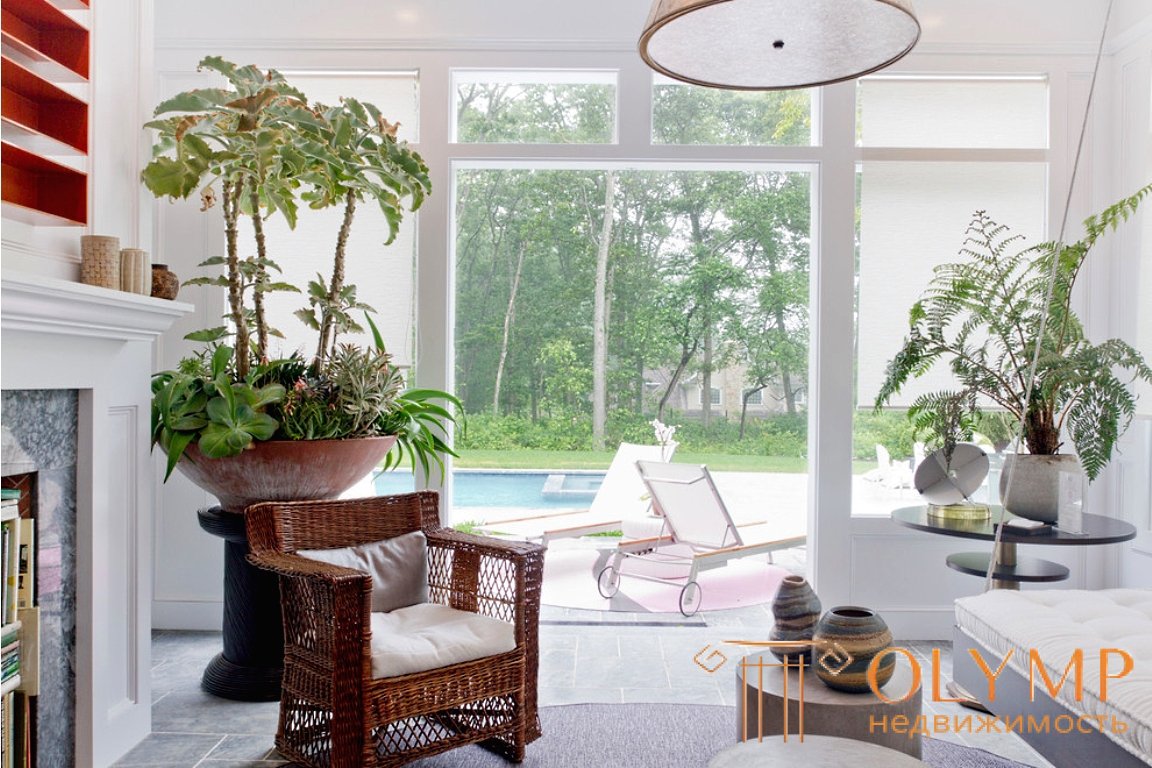

A potted group is a collection of plants planted in separate pots, but located close to each other. However, it is by no means a spontaneous cluster of flower pots. The basis of the pot group is based on the basic principles of grouping, which allow creating a harmonious composition.
Compared with a single placement, the pot group has a number of advantages:
- an interesting appearance (a kind of green oasis in the desert of frozen furniture);
- facilitated care of plants "(mainly in relation to irrigation);
- the creation of an environment with high humidity, allowing you to grow delicate tropical plants.
To create a standard one-sided pottery group, 4-12 flower pots with plants are selected that have similar requirements for keeping conditions (light, temperature and air humidity, irrigation). The main mass of the group is formed by decorative-leaf plants, which are grouped in such a way as to obtain a certain decorative effect. In the foreground or among the array of green foliage put 1-2 pots of decorative flowering plants. In the background are usually placed the highest specimens with darker or larger leaves. In the absence of such, the plants of the background are recommended to be put on supports, which increase their height. In the pot groups, you can also use ampelous plants, which are usually placed in the middle part of the group and allow flexible hanging stems to beautifully frame your own and standing next to the pots. Group composition does not have to be horizontal. In some cases, it is more appropriate vertical arrangement of plants, which is possible thanks to special supports. To create a vertical group, be sure to use at least one ampelous plant or liana. Vertical compositions are usually used to decorate the corners of a room or to divide a room into two parts.
Group composition can be successfully used in the design of the window sill.
In a room garden, plants can be planted in one common container either directly or in flower pots placed in a container filled with soil mixture. As a rule, plants in the indoor garden feel more comfortable than in potted groups. But on the other hand, this composition has its drawbacks, which include:
- crowded;
- poor ventilation;
- the danger of disease or damage by pests of a large number of plants at the same time.
The position of the plants in the indoor garden can be improved by timely thinning so that the plants do not interfere with each other’s growth. In order to avoid pests and diseases, the kindergarten should be regularly inspected. Rotted shoots and flowers are removed in a timely manner.
All plants of indoor garden should be varied in height, shape and color of leaves. At the same time, it is necessary to take into account the correspondence of plant sizes to container dimensions. The overall height of the composition determines the height of the largest plant. In this case, too high specimens should be avoided. The main part of the kindergarten consists of ornamental-leaf plants, against which beautiful flower specimens are planted. At the same time in the center of the container it is necessary to place a pot with a shade-tolerant plant, since its share will be less light than the proportion of plants planted at the edges. To soften the angular contours of the container, in the garden it is recommended to plant an ampelous plant or a liana (ivy, tradescantia, dwarf ficus, zebrina).
As a container for indoor garden, you can use any waterproof vessel of sufficient size. This may be an ordinary plastic box, a special flower box, a copper basin, a small bowl (for a garden of succulents or cacti), a wooden box, etc. The inside surfaces of a wooden container must be treated with a waterproof composition (but by no means creosote!) .
It is better to plant in a container in separate pots. This will facilitate the care of the garden as a whole and allow, if necessary, to quickly remove any plant (for example, when transplanting into a larger pot, when removing a faded annual plant, or in the event of a pest injury). Pots set on top of the drainage layer of sand, pebbles or small gravel. The gaps between the pots are filled with peat so that it reaches the very top of the pots. Peat must always be kept wet, but not poured.
An interesting solution seems to be a hanging garden, which is created using a hanging basket of sufficient size. In this case, the pots of plants are planted in a waterproof container, which is then placed in a basket. To facilitate the care of the hanging garden, the hanging basket is placed at eye level, and not under the ceiling itself. It should be noted that the plants in the hanging garden feel better than their counterparts on the windowsill, since the air is warmer at a height of several meters from the floor (unless the basket is fixed in a place of increased air circulation).
Another type of indoor garden - the so-called "flowering pot." This is a small container with decor-leaf plants, in the midst of which cut flowers are inserted. Creating a flower pot is easy. In a peat between flower pots placed a glass or metal tube filled with water. The cut flowers are put into it, and they are replaced as they wither.
A special kind of indoor garden is a landscape composition that represents a real landscape in miniature. Here you can find not only tiny plants (including bonsai), but also paths, ponds, distinguish buildings and even figurines of people and animals. Naturally, the creation of landscape composition and care for it requires special knowledge and skills from the grower.
Что бы оставить комментарий войдите
Комментарии (0)